General election 2019: preview of London
More than in any other region, the 2019 general election contest in the capital is likely to be shaped by the strength of popular support for remaining in the EU, and how that translates into votes for either Labour or the Liberal Democrats. London has been increasingly strong for Labour in recent general elections, though they are down in recent polls. As part of our series of election previews, the Democratic Audit team reviews the likely outcomes for the parties, marginal seats, and how the latest polling affects the contest in the capital.
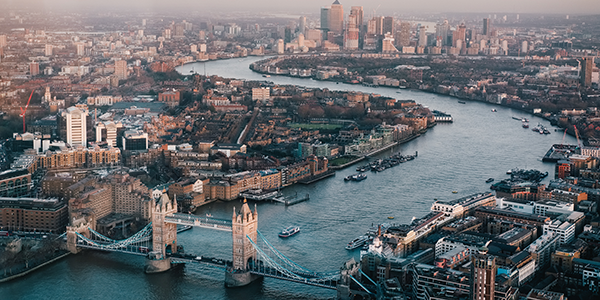
Photo by Benjamin Davies on Unsplash
In the 2017 general election Labour won 55% of the votes in Greater London (and 49 of the city’s 73 seats), building on Sadiq Khan’s mayoral win in 2016. In the European Parliament elections, though, the Lib Dems surged through inner London Labour stronghold boroughs such as Lambeth and Islington. Which of these two factors prevail may determine the winners of seats that, on the latest polling, look to be three-way contests, such as Kensington, Putney, and Cities of London and Westminster. However, the Brexit Party picked up two of London’s MEP seats and 18% of the vote in the European Parliament elections, and outer parts of the city are more Conservative-leaning and Eurosceptic.
Map of London 2017 general election results, with key seats labelled
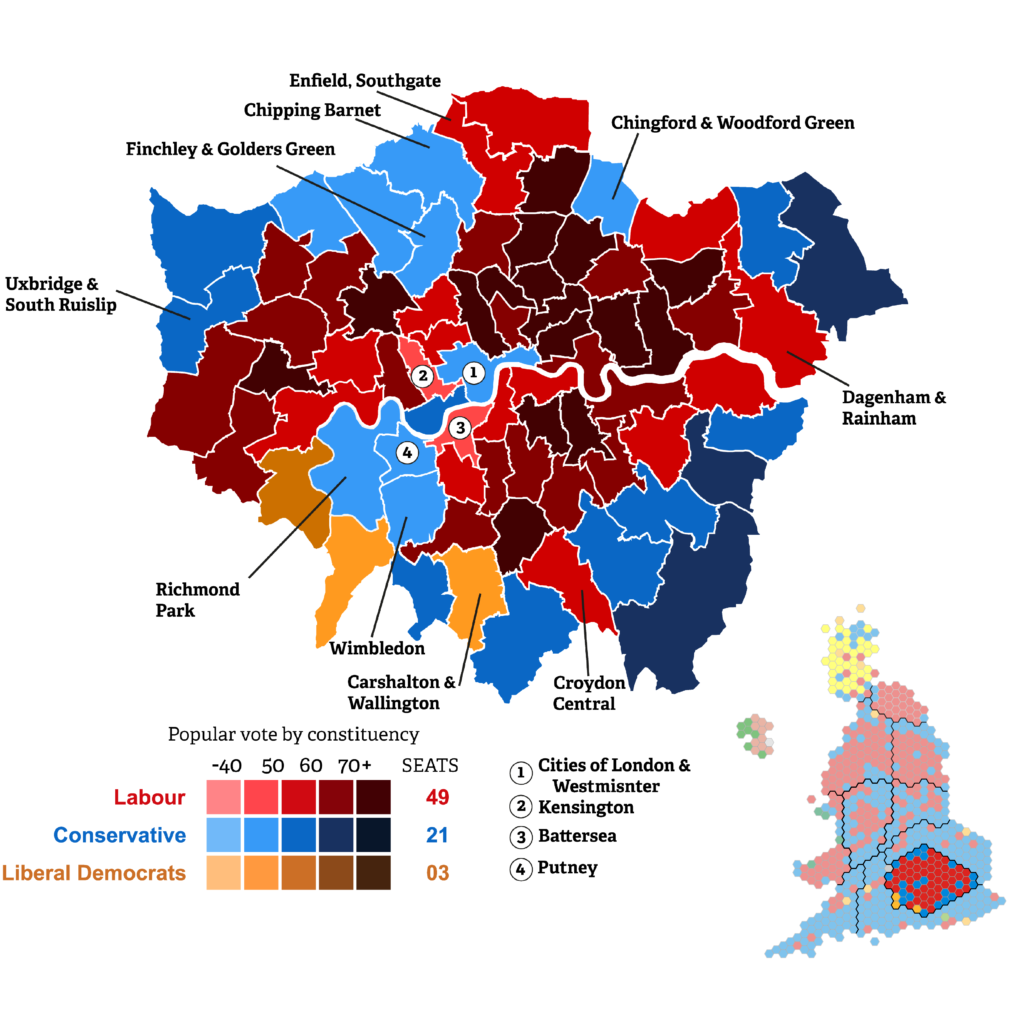
Source: Adapted from map by DrRandomFactor & Ch1902 /Wikipedia. Key constituency contests for 2019 labelled.
For all seats in the city, you can find full details of the candidates standing in 2019 and their social media links at DemocraticDashboard.com. It also gives complete results from the 2017 general election in each area, estimated 2016 EU referendum results and details about the constituency so you can best make up your own mind how to vote.
Near the start of the campaign, Lewis Baston and Dave Hill identified 25 seats which have the possibility of changing hands in London, though since then the numbers have consolidated, with just three forecast to change hands in YouGov’s large MRP poll published on 27 November (see Figure 1). This polled a sample of 100,319 people across the UK, and used this, along with demographic and other data, to create estimates for each constituency. This poll can be supplemented by the latest London-wide poll conducted by YouGov and QMUL (see Figure 2). Both indicate a decline for Labour since 2017, but up on early November polling; the Lib Dems poll higher in London than elsewhere.
Figure 1: Number of seats won by each party at the last three general elections in London, and 2019 estimates from YouGov polling, 27 November
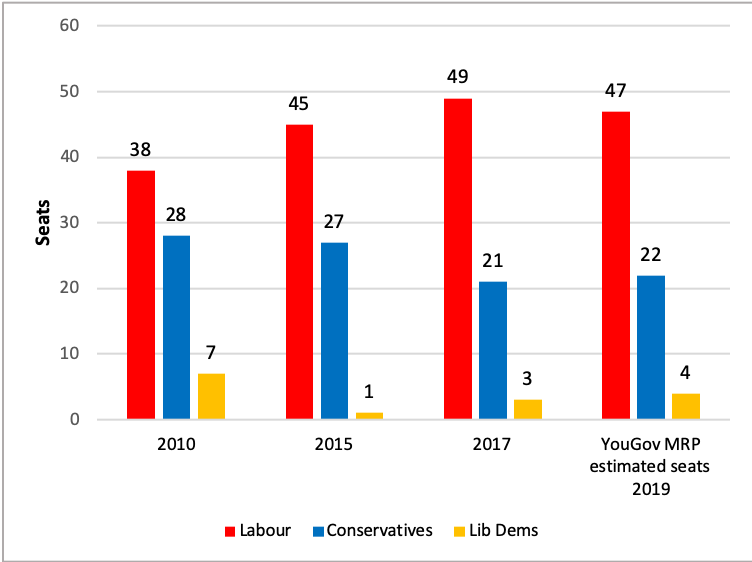
Note: 2019 figures from YouGov MRP seat estimates, 27 November, 2019.
Figure 2: Parties’ shares of the votes in London at the last three general elections, and estimated vote shares in two recent polls (published 27 November and 3rd December)
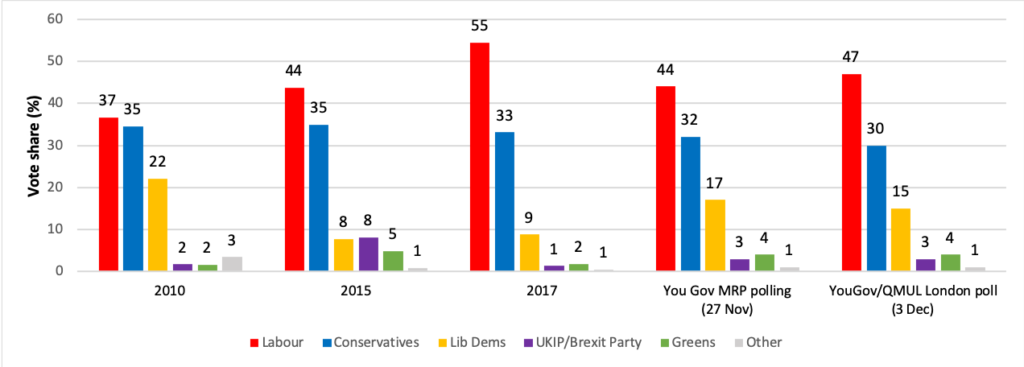
Polling sources: YouGov/MRP data for London from Benjamin Lauderdale and Jack Blumenau for YouGov, 27 Nov national MRP poll. YouGov/QMUL London poll published 3 Dec 2019.
Behind this picture of low overall change is considerable uncertainty about the scale of three-party competition in key seats and the effect of any tactical voting. We start by looking at one particularly complex three-way contest in Kensington, followed by clearer targets for Conservatives, Labour and the Lib Dems.
Three-way contests between Labour, Conservatives and Liberal Democrats
One of the three seats YouGov forecast will change party in London is Kensington, which they estimate will return to the Conservatives. This was one of the most surprising results of 2017, when Labour’s Emma Dent Coad overturned a 20% Conservative majority to win the seat by just 20 votes, with both her and Conservatives on 42%, and the Lib Dems on 12%. This time, the Lib Dems are banking on a high-profile defector, former Tory MP Sam Gyimah, to appeal to pro-Remain Corbyn-sceptic voters here. A mid-November constituency poll put the Conservatives on 36%, Lib Dems on 33% and Labour on 27%, similar to the YouGov MRP estimate which has the Conservatives on 42%, with Labour dropping to third on 26% and the Lib Dems on 29%. The competing Remain tactical voting advice sites are split on which party to recommend. The Conservative candidate is Felicity Buchan.
Other seats where a two-way race between Labour and Conservatives in 2017 might become a complex three-way contest thanks to higher Lib Dem votes in ultra-Remain areas include Conservative-held Putney and Wimbledon. A seat poll in Wimbledon predicts a very close fight between the Conservative incumbent and the Liberal Democrats. The DeltaPoll survey had the Conservative Stephen Hammond on 38%, Liberal Democrat candidate Paul Kohler on 36%, and Labour in third place with 23%. Tactical Remain sites suggest voting Labour in Putney and mostly Lib Dem in Wimbledon.
Conservative targets
For the Conservatives, the challenge is to hold on to formerly safe seats with strong Remain populations, and gain back the four they lost in 2017. As well as Kensington, discussed above, the Conservatives are targeting three further London seats they lost in 2017, Battersea, Enfield, Southgate and Croydon Central, though in each of these Labour took them with larger majorities than Kensington (see Figure 3 below), and the Conservatives are hindered by the Remain-voting tilt of the electorate.
This makes Leave-voting seats on the outer edge of London more likely targets for the Conservatives. Dagenham and Rainham is a Labour seat forecast by YouGov to switch to the Conservatives. Jon Cruddas had a 10% majority here in 2017, but it is the 20th most Leave-leaning seat in the country, with a 70% Leave vote. UKIP have done well here in the past, coming second in 2015. The Brexit Party are also standing here, and YouGov estimates they will take 11% of the vote, while the Conservatives take 40% to Labour’s 38%, which in reality makes it too close to call.
In South West London, Lib Dem MP Tom Brake has continuously held Carshalton and Wallington since 1997, and it was the only seat the party retained in London after their dire results in 2015. The Lib Dems’ majority is slim (2.7%), and the constituency tilts Leave, factors that explain why the Conservatives are currently forecast to take it from the Lib Dems on the YouGov poll from 27 November. It is the Lib Dems’ least safe seat in the capital, though, as in 2015 and 2017, Brake’s personal standing will help.
Seats Labour are targeting
In 2017, Labour candidate Emma Whysall came within 353 votes of defeating the Brexiteer Cabinet minister Theresa Villiers in Chipping Barnet. Though Labour is largely defensive in London, and not forecast to gain any seats on current polling, this marginal pro-Remain seat is a target for them. On YouGov’s polling it is effectively a toss-up between Labour and the Conservatives.
Two other high-profile Labour targets are not quite so marginal, but have attracted press and campaigning attention from both Labour and pro-Remain activists in part because they went from safe Conservative to marginal in 2017 and because of the profile of incumbent Brexiteer Conservatives. Chingford and Woodford Green is currently held by former leader of the party Iain Duncan Smith, and the extent to which his majority shrunk in 2017 was a surprise. He now defends a majority of 2,438 against Labour candidate Faiza Shaheen. Finally, receiving plenty of press attention is Boris Johnson’s own seat of Uxbridge and South Ruislip. On all polling, this is very likely to remain Conservative, but Johnson’s majority was halved in 2017 to a not insurmountable 5,034. Labour opponent Ali Milani is campaigning hard, but it seems an unlikely result for Labour.
Liberal Democrat targets
Though currently held by Conservative Zac Goldsmith, on some measures Richmond Park seems like the Lib Dems’ surest seat in the capital. This affluent pro-Remain seat has switched between Conservatives and Lib Dems over the past decade. Zac Goldsmith took it from the Lib Dems in 2010, and won again in 2015. The seat temporarily reverted to the Lib Dems when Goldsmith stood down in response to the Conservatives’ support for Heathrow expansion, and ran as an independent in the subsequent by-election in December 2016, which the Lib Dems’ candidate Sarah Olney won. She then lost to Goldsmith (back in the Conservative party) by just 45 votes in 2017. Both are standing again, and thanks to the Lib Dems’ focused resurgence, it should be the most straightforward gain for them in the country. The Greens are not standing here, as part of the Unite to Remain pact.
Although the Lib Dems came third in Cities of London and Westminster in 2017, and it would previously have been considered a safe Tory seat, with Labour second-placed challengers, this 72% Remain seat is a top Lib Dem target. Former Labour MP for Streatham, Chuka Umunna, is the Liberal Democrat candidate. A constituency poll by Deltapoll has the Lib Dems on 33%, to the Conservatives’ 39% and Labour’s 26% (survey 14–21 Nov). This three-way contest creates a problem for the tactical Remain sites: those most relying on recent polls recommend a Lib Dem vote. Others rely on the 2017 results to recommend Labour.
As in Cities of London and Westminster, in Finchley and Golders Green, though the Lib Dems came a distant third in 2017 with just 6.6%, they are hoping a perfect combination of a high Remain vote in 2016 (est. 69%) and a high-profile Labour defector in Luciana Berger can help them leapfrog Labour and challenge the Conservative incumbents here. It is also a seat in which around 20% of voters are Jewish, which, given Berger left the Labour party over the anti-semitic abuse she received while a Labour MP, could be decisive. Most Remain tactical sites recommend a Lib Dem vote here, and an early constituency poll (7–13 Nov) placed Berger second on 32% to Labour’s 19% and Conservatives’ 46%, though it’s worth noting that this was at the Lib Dems’ polling peak at the start of the campaign, and that constituency polls have rarely been accurate in past elections.
Figure 3: London’s most marginal seats (by % vote) from the 2017 election
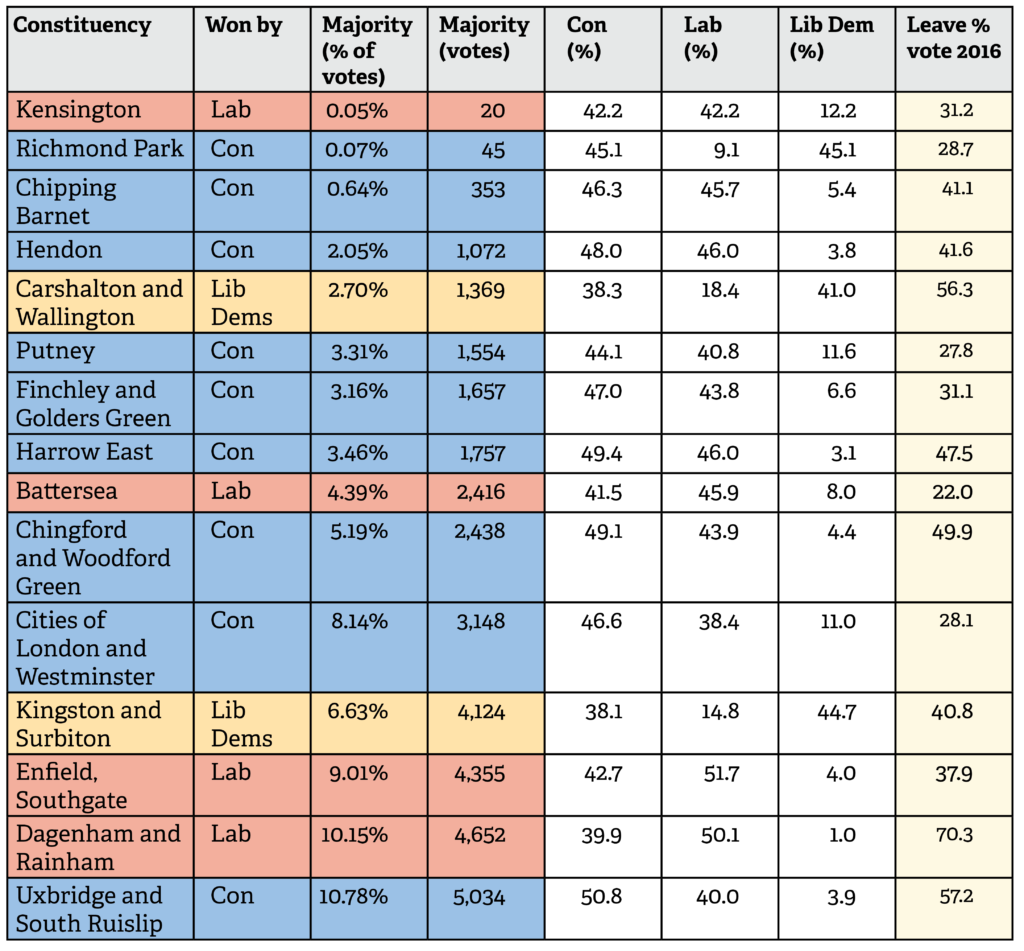





 Democratic Audit's core funding is provided by the Joseph Rowntree Charitable Trust. Additional funding is provided by the London School of Economics.
Democratic Audit's core funding is provided by the Joseph Rowntree Charitable Trust. Additional funding is provided by the London School of Economics.